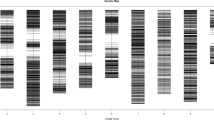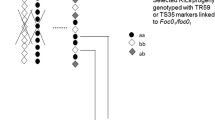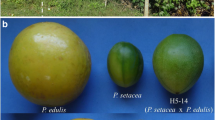Abstract
Two recombinant inbred line (RIL) populations derived from intraspecific crosses with a common parental line (JG62) were employed to develop a chickpea genetic map. Molecular markers, flower colour, double podding, seed coat thickness and resistance to fusarium wilt race 0 (FOC-0) were included in the study. Joint segregation analysis involved a total of 160 markers and 159 RILs. Ten linkage groups (LGs) were obtained that included morphological markers and 134 molecular markers (3 ISSRs, 13 STMSs and 118 RAPDs). Flower colour (B/b) and seed coat thickness (Tt/tt) appeared to be linked to STMS (GAA47). The single-/double-podding locus was located on LG9 jointly with two RAPD markers and STMS TA80. LG3 included a gene for resistance to FOC-0 (Foc01/foc01) flanked by RAPD marker OPJ20600 and STMS marker TR59. The association of this LG with FOC-0 resistance was confirmed by QTL analysis in the CA2139 × JG62 RIL population where two genes were involved in the resistance reaction. The STMS markers enabled comparison of LGs with preceding maps.


Similar content being viewed by others
References
Benko-Iseppon AM, Winter P, Huettel B, Staginnus C, Muehlbauer FJ, Kahl G (2003) Molecular markers closely linked to fusarium resistance genes in chickpea show significant alignments to pathogenesis-related genes located on Arabidopsis chromosomes 1 and 5. Theor Appl Genet 107:379–386
Cho S, Kumar J, Shultz JL, Anupama K, Tefera F, Muehlbauer FJ (2002) Mapping genes for double podding and other morphological traits in chickpea. Euphytica 128:285–292
Cho S, Chen W, Muehlbauer FJ (2004) Pathotype-specific genetic factors in chickpea (Cicer arietinum L.) for quantitative resistance to ascochyta blight. Theor Appl Genet 109:733–739
Churchill GA, Doerge RW (1994) Empirical threshold values for quantitative trait mapping. Genetics 138:963–971
Collard BCY, Pang ECK, Ades PK, Taylor PWJ (2003) Preliminary investigation of QTLs associated with seedling resistance to ascohyta blight from Cicer echinospermum, a wild relative of chickpea. Theor Appl Genet 107:719–729
FAOSTAT-Agriculture (2004) Database. http://www.fao.org/waicent/portal/statistic.es.asp.
Flandez-Galvez H, Ford R, Pang ECK, Taylor PWJ (2003) An intraspecific linkage map of the chickpea (Cicer arietinum L.) genome based on sequence tagged microsatellite site and resistance gene analog markers. Theor Appl Genet 106:1447–1456
Gaur PM, Slinkard AE (1990a) Inheritance and linkage of isozyme coding genes in chickpea. J Hered 81:455–461
Gaur PM, Slinkard AE (1990b) Genetic control and linkage relations of additional isozyme markers in chickpea. Theor Appl Genet 80:648–656
Gil J, Cubero JI (1993) Inheritance of seed coat thickness in Chickpea (Cicer arietinum L.) and its evolutionary implications. Plant Breed 111:257–260
Gil J, Nadal S, Luna D, Moreno MT, de Haro A (1996) Variability of some physico-chemical characters in Desi and Kabuli chickpea types. J Sci Agric 71:179–184
Gumber RK, Kumar J, Haware MP (1995) Inheritance of resistance to fusarium wilt in chickpea. Plant Breed 114:277–279
Hajj Moussa E, Millan T, Gil J, Cubero JI (1996) Variability and genome length estimation in chickpea (Cicer arietinum L.) revealed by RAPD analysis. J Genet Breed 51:83–85
Halila MH, Strange RN (1996) Identification of the causal agent of wilt of chickpea in Tunisia as Fusarium oxysporum f.sp. ciceri race 0. Phytopath Medit 35:67–74
Haware MP, Nene YL (1982) Races of Fusarium oxysporum f.sp. ciceris. Plant Dis 66:809–810
Hüttel B, Winter P, Weising K, Choumane W, Weigand F, Kahl G (1999) Sequence-tagged microsatellite-site markers for chickpea (Cicer arietinum L.). Genome 42:210–217
Jiménez-Díaz RM, Crino P, Halila MH, Mosconi C, Trapero-Casas A (1993) Screening for resistance to fusarium wilt and ascochyta blight in chickpea. In: Singh KB, Saxena MC (eds) Breeding for stress tolerance in cool-season food legumes. ICARDA, Wiley, Chichester, UK, pp 77–95
Jiménez-Gasco MM, Jiménez-Díaz RM (2003) Development of a Specific Polymerase Chain Reaction-Based Assay for the identification of Fusarium oxysporum f. sp. ciceris and its pathogenic races 0, 1A, 5 y 6. Phytopathology 93:200–209
Jiménez-Gasco MM, Pérez-Artés E, Jiménez-Diaz RM (2001) Identification of pathogenic races 0, 1B/C, 5 and 6 of Fusarium oxysporum f.sp. ciceris with random amplified polymorphic DNA (RAPD). Eur J Plant Pathol 107:237–248
Johnson HW, Bernard RL (1962) Soybean genetic and breeding. Adv Agrom 14:149–221
Kaiser WJ, Alcalá-Jiménez AR, Hervás-Vargas A, Trapero-Casas A, Jiménez-Díaz RM (1994) Screening wild Cicer species for resistance to races 0 and 5 of Fusarium oxysporum f. sp. ciceris. Plant Dis 78:962–967
Kazan K, Muehlbauer FJ, Weeden NF, Ladizinsky G (1993) Inheritance and linkage relationships of morphological and isozyme loci in chickpea (Cicer arietinum L.). Theor Appl Genet 86:417–426
Kelly AG, Alcalá-Jiménez AR, Bainbridge BW, Heale JB, Pérez-Artés E, Jiménez-Díaz RM (1994) Use of genetic fingerprinting and random amplified polymorphic DNA to characterize pathotypes of to Fusarium oxysporum f. sp . ciceris infecting chickpea. Phytopathology 84:1293–1298
Kosambi DD (1944) The estimation of map distance from recombination values. Ann Eugen 12:172–175
Kumar S (1998) Inheritance of resistance to Fusarium wilt (race 2) in chickpea. Plant Breed 117:139–142
Lander ES, Botstein D (1989) Mapping Mendelian factors underlying quantitative traits using RFLP linkage maps. Genetics 121:185–199
Lassner MW, Peterson P, Yoder JI (1989) Simultaneous amplification of multiple DNA fragment by polymerase chain reaction in the analysis of transgenic plants and their progeny. Plant Mol Biol Rep 7:116–128
Mayer MS, Tullu A, Simon CJ, Kumar J, Kaiser WJ, Kraft JM, Muehlbauer FJ (1997) Development of a DNA marker for fusarium wilt resistance in chickpea. Crop Sci 37:1625–1629
Moreno MT, Cubero JI (1978) Variation in Cicer arietinum L. Euphytica 27:465–485
Muehlbauer FJ, Singh KB (1987) Genetics of chickpea. In: Saxena MC, Singh KB (eds) The chickpea. CAB International, UK, pp 99–125
Nene YL, Reddy MV (1987) Chickpea diseases and their control. In: Saxena MC, Singh KB (eds) The chickpea. CAB International, UK, pp 233–270
Ooijen JW van (1992) Accuracy of mapping quantitative trait loci in autogamous species. Theor Appl Genet 84:803–811
Ooijen JW van (2004) MapQTL 5, Software for the mapping of quantitative trait loci in experimental populations. Plant Research International Wageningen, The Netherlands
Ooijen JW van, Voorrips RE (2001) JoinMap 3.0, Software for the calculation of genetic maps. Plant Research International Wageningen, The Netherlands
Rajesh PN, Tullu A, Gil J, Gupta VS, Ranjekar PK, Muehlbauer FJ (2002) Identification of an STMS marker for double-podding gene in chickpea. Theor Appl Genet 105:604–607
Ratnaparkhe MB, Santra DK, Tullu A, Muehlbauer, FJ (1998) Inheritance of inter-simple-sequence-repeat polymorphisms and linkage with a fusarium wilt resistance gene in chickpea. Theor Appl Genet 96:348–353
Román B, Satovic Z, Pozarkova D, Macas J, Dolezel,, Cubero JI, Torres AM (2004). Development of a composite map in Vicia faba, breeding applications and future prospects. Theor Appl Genet 108:1079–1088
Rubio J, Moreno MT, Cubero JI, Gil J (1999) Effect of the gene double pod in chickpea yield, yield components and stability of yield. Plant Breed 117:585–587
Rubio J, Moussa E, Kharrat M, Moreno MT, Millán T, Gil J (2003) Two genes and linked RAPD markers involved in resistance to Fusarium oxysporum f. sp . ciceris race 0 in chickpea. Plant Breed 122:188–191
Santra DK, Tekeoglu M, Ratnaparkhe M, Kaiser WJ, Muehlbauer FJ (2000) Identification and mapping of QTLs conferring resistance to ascochyta blight in chickpea. Crop Sci 40:1606–1612
Sharma KD, Winter P, Kahl G, Muehlbauer FJ (2004) Molecular mapping of Fusarium oxysporum f. sp. ciceris race 3 resistance gene in chickpea. Theor Appl Genet 108:1243–1248
Simon CJ, Muehlbauer FJ (1997) Construction of a chickpea linkage map and its comparison with maps of pea and lentil. J Hered 88:115–119
Singh KB (1987) Chickpea breeding. In: Saxena MC, Singh KB (eds) The chickpea. CAB International, UK, pp 127–162
Smithson JB, Kumar J, Singh H (1983) Inheritance of resistance to Fusarium wilt in chickpea. Int Chickpea Newsl 9:21–22
Tekeoglu M, Tullu A, Kaiser WJ, Muehlbauer FJ (2000) Inheritance and linkage of two genes that confer resistance to fusarium wilt in chickpea. Crop Sci 40:1247–1251
Tekeoglu M, Rajesh PN, Muehlbauer FJ (2002) Integration of sequence tagged microsatellite sites to the chickpea genetic map. Theor Appl Genet 105:847–854
Torres AM, Weeden NF, Martin A (1993) Linkage among isoenzymes, RFLP and RAPD markers in Vicia faba. Theor Appl Genet 85:937–945
Tullu A, Muehlbauer FJ, Simon CJ, Mayer MS, Kumar J, Kaiser WJ, Kraft JM (1998) Inheritance and linkage of a gene for resistance to race 4 of fusarium wilt and RAPD markers in chickpea. Euphytica 102:227–232
Tullu A, Kaiser WJ, Kraft JM, Muehlbauer FJ (1999) A second gene for resistance to race 4 of Fusarium wilt in chickpea and linkage with a RAPD marker. Euphytica 109:43–50
Udupa SM, Baum M (2003) Genetic dissection of pathotype-specific resistance to ascochyta blight disease in chickpea (Cicer arietinum L.) using microsatellite markers. Theor Appl Genet 106:1196–1202
Upadhyaya HD, Smithson JB, Haware MP, Kumar J (1983) Resistance to wilt in chickpea. II. Further evidence for two genes for resistance to race 1. Euphytica 32:749–755
Vlácilová K, Ohri D, Wrána J, Cihaliková J, Kubaláková M, Kahl G, Dolezel J (2002) Development of cytogenetics and physical genome mapping in chickpea (Cicer arietinum L.). Chromosome Res 10:695–706
Williams PC, Singh U (1987) Nutritional quality and the evaluation of quality in breeding programmes. In: Saxena MC, Singh KB (eds) The chickpea. CAB International, UK, pp 329–356
Williams SJ, Kubelik AR, Livak KJ, Rafalski A, Tingey SV (1990) DNA polymorphisms amplified by arbitrary primers are useful as genetic markers. Nucleic Acids Res 18:6531–6535
Winter P, Pfaff T, Udupa SM, Hüttel B, Sharma PC, Sahim S, Arreguin-Espinoza R, Weigand F, Muehlbauer FJ, Kahl G (1999) Characterization and mapping of sequence-tagged microsatellite sites in the chickpea (Cicer arietinum L.) genome. Mol Gen Genet 262:90–101
Winter P, Benko-Iseppon AM, Hüttel B, Ratnaparkhe M, Tullu A, Sonnante G, Pfaff T, Tekeoglu M, Santra D, Sant VJ, Rajesh PN, Kahl G, Muehlbauer FJ (2000) A linkage map of the chickpea (Cicer arietinum L.) genome based on recombinant inbred lines from a C. arietinum × C. reticulatum cross: localization of resistance gene for fusarium wilt races 4 and 5. Theor Appl Genet 101:1155–1163
Winter P, Staginnus C, Sharma PC, Kahl G (2003) Organisation and genetic mapping of the chickpea genome. In: Jaiwal PK, Singh RP (eds) Improvement strategies for leguminosae biotechnology. Kluwer, UK, pp 303–351
Acknowledgements
We are indebted to Dr. P. Winter for his valuable comments and suggestions. We wish to thank to CICYT (contract no. AGL2001-2018-C02-01) for the financial support of this work.
Author information
Authors and Affiliations
Corresponding author
Additional information
Comunicated by F.J. Muehlbauer
Rights and permissions
About this article
Cite this article
Cobos, M.J., Fernández, M.J., Rubio, J. et al. A linkage map of chickpea (Cicer arietinum L.) based on populations from Kabuli × Desi crosses: location of genes for resistance to fusarium wilt race 0. Theor Appl Genet 110, 1347–1353 (2005). https://doi.org/10.1007/s00122-005-1980-1
Received:
Accepted:
Published:
Issue Date:
DOI: https://doi.org/10.1007/s00122-005-1980-1




